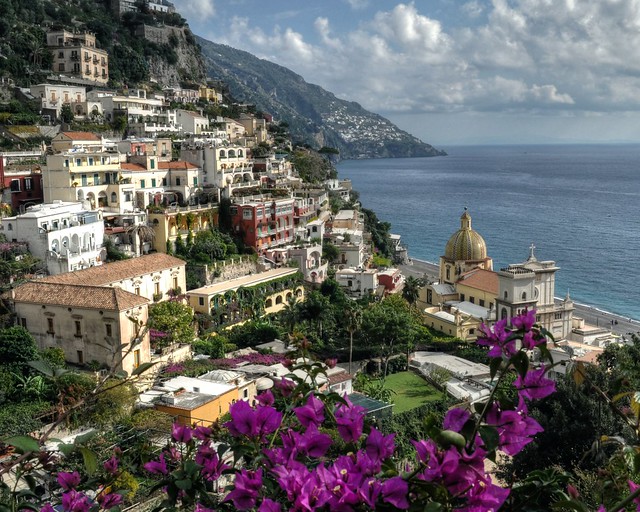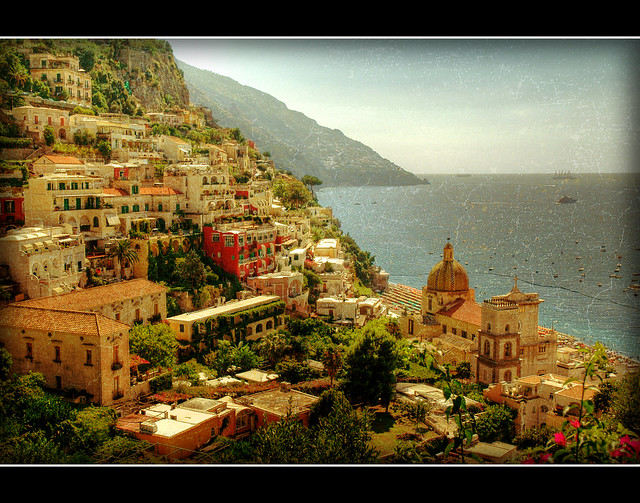The Amalfi Coast lies in the southwestern region of Campania, Italy. For its extraordinary beauty and its iconic medieval cliffside Mediterranean fishing villages, it is recognized as a UNESCO World Heritage Site.

Declared one of the UNESCO World Heritage Sites for its undisputed beauty and the uniqueness of its natural landscape, the Amalfi Coast is the land characterised by the oxymoronic combination between mountain and sea, the farmer and the fisherman. The mountain, that thanks to the intense work of man, has been adapted to the demands of life over the ages. It plunges steeply into a sea, creating charming coves, deep fjords, cliffs, caverns, bays, natural arches and small pebble beaches; natural elements that have created, over the centuries, an enchanting, sinuous and seductive landscape: it is certainly not a coincidence that this area is known as the land of the Sirens, in the Homer's epic poem "Odysseus". Typical houses, painted in warm pastel colors, follow the natural slope of the foothills of Mounts Lattari, leaning against each other, creating a very picturesque landscape. From the characteristic terraces, built with dry stone walls, expands the intense scents of the lemon groves, the vineyards, the broom, the bright colors of bougainvillea which, combined with the smell of salt air, creates a unique sensory experience.
Thirteen are the pearls of this land, located along a stretch of road among the most scenic in the world, ripped from the bare rock, which give the tourists strong emotions, pleasant memories and a strong desire to return as soon as possible to this little piece of heaven on earth:
- Vietri sul Mare, the gateway to the Amalfi Coast, coming from Salerno, famous throughout the world for the production of ceramics, with its intense and vivid colors, and the beautiful hill towns of Albori and Raito;
- Cetara, a small fishing village, that has become famous over the years for its fishing related products, creating culinary specialties appreciated world-wide, such as the salted anchovy sauce and red tuna, for example;
- Maiori, the ancient Reghinna Major, which, despite the wide promenade and appearance of the new town, hides a very charming old town, made up of narrow streets and alleys, dominated by the imposing castle of San Nicola de Thoro Plano, to the north, and the Collegiate Church of Santa Maria a Mare, to the west;
- Tramonti, a group of villages and districts set among the green mountains, covered with vineyards, away from the clamor of the other coastal countries, well known for its authentic flavors, the excellent wines and dairy products;
- Minori, the ancient Reghinna Minor, with the remains of the Roman Villa of the I century A.D., the magnificent Basilica of Santa Trofimena and the tasty hand-made pasta, gastronomic specialty of the town;
- Atrani, one of the smallest municipalities in Southern Italy, with its picturesque square and the ancient church of San Salvatore de' Birecto (X century), where during the times of the ancient Maritime Republic of Amalfi, the Dukes (Dogi) received their official investiture;
- Ravello, which, with its breathtaking views, at the top of its 350 meters above sea level, with its beautiful patrician villas (Rufolo and Cimbrone), the cathedral of San Pantaleone and its architectural treasures, have enchanted over the centuries important writers, artists and chiefs of state, such as: Boccaccio, Wagner, DH Lawrence, V. Woolf, Gore Vidal, Ingrid Bergman, Greta Garbo, Humphrey Bogart, JF Kennedy and his wife Jacqueline, and many others;
- Scala, full of fascinating corners over the coastline and important monuments. It is the oldest town of the Amalfi Coast and was the birthplace of Fra' Gerardo Sasso, founder of the Knights of Malta;
- Amalfi, the first of the four Maritime Republics in Italy, with its imposing Cathedral entitled to St. Andrew, preceded by an imposing staircase, the ancient arsenals of the Republic, the Cloister of Paradise and the Paper Museum, in which tourists and curious can admire the antique methods of production of the precious handmade paper of Amalfi;
- Conca dei Marini, a village overlooking the deep blue sea with the spectacular Emerald Grotto, the scenic church of San Pancrazio, the austere convent of Santa Rosa, perched to the rock, where the famous "sfogliatella Santa Rosa" was realized for the first time;
- Furore, also known as "the town that does not exist", with its deep fjord characterised by a wild beauty, the "en plein air" murals and the small villages scattered along the slopes of the mountain;
- Praiano, with its narrow streets scented of geraniums, the beach of La Praia, the Saracen towers, the majolica dome of the Church of St. Luca the Evangelist, the impressive Monastery of Santa Maria a Castro and its romantic sunsets, admiring the bay of Positano, the Sorrento Peninsula and the Faraglioni of Capri;
- Positano, the pearl of the Divine Coast, with its typical "Moda Positano" sandals and linen clothes craft shops, the charm of its old noble palaces, the Church of the Assumption (near which were recently unearthed the remains of a Roman villa) and the charming panorama of the "Li Galli" islands in the background.

The Amalfi Coast (Italian: Costiera Amalfitana) is a stretch of coastline on the southern coast of the Sorrentine Peninsula in the Province of Salerno in Southern Italy. The Amalfi Coast is a popular tourist destination for the region and Italy as a whole, attracting thousands of tourists annually. During the 10th–11th centuries, the Duchy of Amalfi existed on the territory of the Amalfi Coast, centered in the town of Amalfi. The Amalfi coast was later controlled by the Principality of Salerno, until Amalfi was sacked by the Republic of Pisa in 1137. Since then the Amalfi coast has experienced a crisis. But after the unification of Italy the Amalfi coast has enjoyed a huge economic revival, prompted even by the international tourism. In 1997, the Amalfi Coast was listed as a UNESCO World Heritage Site as a cultural landscape.
Like the rest of the region, the Amalfi Coast lies in a Mediterranean climate, featuring warm summers and mild winters. It is located on the relatively steep southern shore of the Sorrentine Peninsula, leaving little room for rural and agricultural territories. The only land route to the Amalfi Coast is the 40 kilometres (25 miles) long Strada Statale 163 which runs along the coastline from the town of Vietri sul Mare in the east to Positano in the west. Thirteen municipalities are located on the Amalfi Coast, many of them centered around tourism.
The Amalfi Coast is known for its production of limoncello liqueur as the area is a known cultivator of lemons, known as sfusato amalfitano in Italian, which are grown in terraced gardens along the entire coast between February and October. Amalfi is also a known maker of a hand-made thick paper which is called bambagina. Other renowned local products are a particular kind of anchovies (local Italian: alici) from Cetara, and the colorful handmade ceramics from Vietri.

What To See
The Amalfi coast is renowned for its diversity; every town has its own character and interesting sites. The most noticeable places to visit on the Amalfi coast are:
- The Duomo (the cathedral) in Amalfi, and its cloister (Chiostro del Paradiso in Italian)
- The church of Santa Maria Assunta in Positano
- The churches of San Salvatore del Birecto and of Santa Maria Maddalena in Atrani
- Villa Cimbrone and Villa Rufolo in Ravello
- The churches of San Luca and San Gennaro in Praiano and their viewpoints
- The church of San Pancrazio in Conca dei Marini and its viewpoint
- The church of Santa Trofimena and the ancient Roman villa in Minori
- The Fjiord of Furore with the Mulino Cartiera (Paper Mill) and the "Monazzeni" of Anna Magnani & Roberto Rossellini Furore

Nearby Places Of Interest
- Visit nearby Herculaneum and Pompeii.
- Climb Mount Vesuvius
- Visit Paestum
- Visit Naples
- Visit Capri
- Visit Ischia, an island outside Naples.
- Visit Praia a Mare, about 150 km south of the Amalfi Coast
Source: Wikipedia, Wikitravel
















0 comments:
Post a Comment